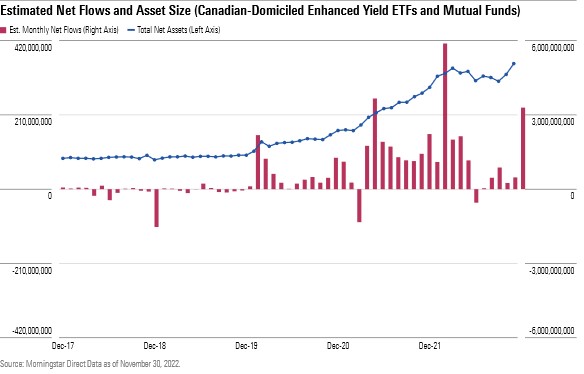
Is Enhanced Yield Still a Thing?
As we exit an era of historically low interest rates in exchange for one with rising rates, savvy fund investors will notice the growth of yield-focused equity mutual funds and ETFs.
Enhanced yield funds, as they're called, have helped cashflow-hungry investors find additional income from their equity portfolio during a time when bonds paid very little, and they're still useful now.
Though the era of ultra-low interest rates has passed, many investors will still find utility in these products. Retirees, for example, who still wish to invest in equities but require a steady income might benefit from such strategies. Using the Morningstar Direct database, we screened for Canadian-domiciled funds and ETFs that fit the ‘enhanced yield’ descriptor to find 42 funds. This gives us an idea of just how popular these products are.

How Do Enhanced Yield ETFs and Mutual Funds Work?
1) Covered Calls
At the heart of many of these funds, is a covered call options strategy that looks something like this:
Here, an investor holds a stock that today is worth $100. That investor sells a call option for $5, for the right to purchase the stock at $120. In a nutshell, the investor is wagering that the price of the stock will not go higher than $120, since the buyer of that option will likely not exercise that right. If the stock surges to say, $140, the investor’s profit is capped off at $25 since they must sell the stock for $120 to the holder of the option (which excludes the $5 premium already in pocket). Notice on the chart that there is no downside limit protection. If the stock falls in price, so too does the investor’s overall position, with a small buffer of $5 pocketed from selling the option initially.
Repeated for a portfolio of stocks and at scale, this concept forms the basis of many enhanced yield ETFs. The key point is that the ‘enhancement’ of yield comes from giving up the upside potential of your portfolio in exchange for income.
2) Factor Weighting
Instead of holding a basket of stocks weighted by market cap (like you would be if you held popular ETFs like XIU and SPY), why not weight those stocks according to their dividend yields? The result of doing so would be a portfolio that pays a higher dividend, relative to a traditional index. Though not particularly sophisticated, this approach is one of several ‘smart beta’ or what Morningstar more appropriately calls ‘strategic beta’ products. These products purposefully grant an investor exposure to a specific investment factor, like dividends, by following a set of pre-determined index rules. This strategy straddles the line between active and passive investing since products give you active exposure to a factor but at the fraction of the management fee charged by actively managed products.
The downside? These products are designed to grant exposure to higher relative dividend payers, for better or for worse. One situation where this might hurt an investor is the classic value trap. If a stock falls in price, the yield looks higher. As such, a rules-based yield index might buy more of this stock upon re-balancing, perhaps without considering the broader situation at the company. So, though the yield will surely be higher than the traditional index, returns may not be.
Should Canadian Investors Focus on Dividends?
Above all else remember that having a higher dividend yield from your portfolio does not necessarily mean you will get higher returns over time. Case in point, here’s what dividend funds as a category did over the last 10 years against the plain vanilla Canadian equity category:
Consider the Advantages of Capital Gains
Over 10 years, the average dividend fund performed very much like a plain equity fund. The Canadian tax law also favours investor return via capital gain over dividends and income. Hence, investors who don’t require a steady monthly cash flow may consider not limiting their options to only enhanced yield funds. With discipline, dividends can also be created synthetically by periodically selling off a small portion of the portfolio for cashflow.
This article does not constitute financial advice. Investors are encouraged to conduct their own independent research before buying or selling any investment.




















